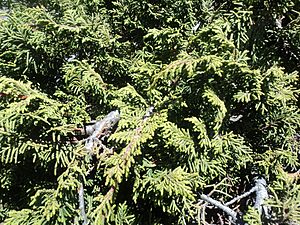Mountain juniper facts for kids
Quick facts for kids Mountain juniper |
|
|---|---|
 |
|
| Conservation status | |
| Scientific classification | |
| Genus: |
Juniperus
|
| Species: |
monticola
|
The Juniperus monticola, often called the mountain juniper, is a special type of tree. It belongs to the conifer family, which means it has needles and produces cones, like pine trees. This unique tree is found only in Mexico, growing high up in the mountains.
Contents
What is Mountain Juniper?
The mountain juniper is an evergreen tree. This means it keeps its green needles all year round, even in winter. It's a tough plant that can grow in difficult places. These trees are known for their strong wood and ability to survive in harsh mountain weather.
Where Does it Live?
Mountain junipers are native to Mexico. You can find them in the high mountain ranges of central Mexico. They often grow in places that are very rocky and have thin soil. These trees are well-suited to cold temperatures and strong winds. They thrive in areas with lots of sunlight.
What Does it Look Like?
The mountain juniper can grow to be a medium-sized tree. It usually reaches heights of about 10 to 20 meters (33 to 66 feet). Its trunk can be quite thick. The bark is reddish-brown and often peels off in strips.
Its leaves are small and scale-like. They are pressed close to the branches. These leaves are a dark green color. The tree produces small, round cones. These cones look a bit like berries. They start green and turn a dark blue or black color when they are ripe. Birds and other animals often eat these "berries."
How Does it Grow and Reproduce?
Like other conifers, the mountain juniper reproduces using cones. It has separate male and female cones on the same tree.
- Male cones produce pollen. This pollen is carried by the wind.
- Female cones contain the seeds. When pollen lands on a female cone, it can fertilize the seeds.
After fertilization, the female cones develop into the berry-like structures. These "berries" mature over one or two years. When they are ripe, they fall to the ground. Animals that eat them help spread the seeds. This helps new mountain juniper trees grow in different places.
Why is it Important?
Mountain junipers play an important role in their mountain homes. They help prevent soil erosion on steep slopes. Their roots hold the soil in place. Many animals, like birds and small mammals, rely on the juniper's "berries" for food. The dense branches also provide shelter for wildlife.
Historically, the wood of juniper trees has been used by local communities. It is strong and resistant to decay. People have used it for building and for fuel. The tree's ability to grow in harsh conditions makes it a valuable part of the mountain ecosystem.
Is it in Danger?
The Juniperus monticola is currently listed as "Least Concern" by conservation groups. This means it is not considered to be in immediate danger of disappearing. However, like all plants, its habitat can be affected by changes in climate or human activities. Protecting its mountain home is important for its continued survival.
See also
 In Spanish: Juniperus monticola para niños
In Spanish: Juniperus monticola para niños


